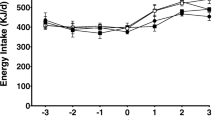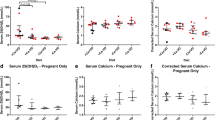Abstract
We have previously shown that a low-copper (Cu) diet produced alterations in placental Cu transport and fetal Cu stores. Because Cu deficiency has been associated with lipid deposition in rat dam liver, we hypothesized that a high fat intake, a prevalent dietary habit in many populations, may worsen fetal Cu status and its closely linked iron (Fe) deposits. Pregnant rats were fed one of four diets during the second half of gestation: NFNCu: normal fat (7%), normal Cu (6 mg/kg); HFNCu: high fat (21%), normal Cu; NFLCu: normal fat, low Cu (0.6 mg/kg), and HFLCu: high fat, low Cu. One day before delivery, dams were anesthetized, and maternal as well as fetal plasma and tissues were obtained. Maternal, fetal, and placental weights were indistinguishable regardless of the group. Dam plasma Cu and placental Cu were lower in both LCu groups than in the NFNCu or the HFNCu groups. However, fetal plasma Cu was similar in all treatment groups. Dam and fetal liver Cu stores were reduced in the LCu groups compared to the NCu groups. This resulted in lower fetal/maternal liver Cu ratios in the NFLCu (1.79 ± 0.14,p < 0.05) and HFLCu (1.59 ± 0.21,p < 0.05) as compared to the NFNCu (4.12 ± 0.44) and the HFNCu (4.15 ± 0.27). Dam liver Fe was higher in the NFNCu than in HFNCu group (1.10 ± 0.8 vs. 0.89 ± 0.06 μmol/g,p < 0.05); fetal liver Fe from HFNCu and NFLCu dams was lower than that from NFNCu fetuses (NFNCu: 2.42 ± 0.14; HFNCu: 1.92 ± 0.15,p < 0.05; NFLCu: 1.81 ± 0.10,p < 0.01). Fetuses of the HFLCu group had a lower heart Fe than the NFNCu group (0.56 ± 0.03 vs. 44.0 ± 3.0 μg/g,p < 0.01). These data indicate that a maternal high-fat diet can potentially aggravate the effects of Cu deficiency by further altering fetal Cu and Fe tissue stores.
Similar content being viewed by others
References
L. S. Hurley, S. L. Keen, and B. Lönnerdal, Copper in fetal and neonatal development, inBiological Roles of Copper, Ciba Fdn. Symp. 79, Excerpta Medica-Elsevier, Amsterdam, pp. 227–245 (1980).
P. A. Walravens, Nutritional importance of copper and zinc in neonates and infants,Clin. Chem. 26, 185–189 (1980).
J. R. Prohaska and O. A. Lukasewycz, Copper deficiency during perinatal development: effects of the immune system response of mice,J. Nutr. 119, 922–931 (1981).
C. N. Ong, S. E. Chia, S. C. Foo, H. Y. Ong, M. Tsakok, and P. Liouw, Concentrations of heavy metals in maternal and umbilical cord blood,Biometals 6, 61–66 (1993).
W. Wasowicz, P. Wolkanin, M. Bednarski, J. Gromadzinska, M. Sklodowska, and K. Grzybowska, Plasma trace element (Se, Zn, Cu) concentrations in maternal and umbilical cord blood in Poland,Biol. Trace Element Res. 38, 205–215 (1993).
P. Yasodhara, L. A. Ramarajn, and L. Raman, Trace minerals in pregnancy. 1. Copper and zinc,Nutr. Res. 11, 15–21 (1991).
T. M. Allen, A. Manoli, and R. L. Lamont, Skeletal changes associated with copper deficiency,Clin. Orthop. 148, 206–210 (1982).
C. R. Paterson and J. Burns, Copper deficiency in infancy,J. Clin. Biochem. Nutr. 4, 175–190 (1980).
R. G. Hopkins and M. L. Failla, Chronic intake of a marginally low copper diet impairs in vitro activities of lymphocytes and neutrophils from male rats despite minimum impact on conventional indicators of copper status,J. Nutr. 125, 2658–2668 (1995).
R. A. Wapnir, I. Gyasi, R. G. Harper, J. Moyse, and S. Teichberg, Placental copper transport in the rat. II: Effect of maternal copper deficiency,Placenta 17, 479–486 (1996).
A. Barone, O. Ebesh, R. G. Harper, and R. A. Wapnir, Placental copper transport in rats: effects of elevated dietary zinc on fetal copper, iron and metallothionein,J. Nutr. 128, 1037–1042 (1998).
R. A. Wapnir and M. C. Sia, Copper intestinal absorption in the rat: effect of free fatty acids and triglycerides,Proc. Soc. Exp. Biol. Med. 211, 381–386 (1996).
A. A. Al-Othman, F. Rosenstein, and K. Y. Lei, Copper deficiency increase in vivo hepatic synthesis of fatty acids, triacylglycerols, and phospholipids in rats,Proc. Soc. Exp. Biol. Med. 204, 97–103 (1993).
M. Fields and C. G. Lewis, Hepatic iron overload may contribute to hypertriglyceridemia and hypercholesterolemia in copper-deficient rats,Metabolism 46, 377–381 (1997).
E. D. Harris, The iron-copper connection: the link to ceruloplasmin grows stronger,Nutr. Rev. 53, 170–173 (1995).
P. G. Reeves, F. H. Nielsen, and G. C. Gahey, Jr., AIN-93 purified diets for laboratory rodents: final report of the American Institute of Nutrition ad-hoc writing committee on the reformulation of the AIN-76A rodent diet,J. Nutr. 123, 1939–1951 (1993).
S. Onosaka and M. G. Cherian, Comparison of metallothionein determination by polarographic and cadmium saturation methods,Toxicol. Appl. Pharmacol. 63, 270–274 (1982).
J. A. Knight, S. Anderson, and J. M. Rawle, Clinical basis of the sulfo-phospho-vanillin reaction for estimating total serum lipids,Clin. Chem. 53, 89–91 (1972).
I. E. Buchan,Arcus® Pro-Stat v. 3–11. Medical Computing, Aughton, UK.
J. H. Zar,Biostatistical Analysis, 2nd ed., Prentice-Hall, Englewood Cliffs, NJ (1984).
L. E. Klevay and J. T. Saari, Comparative responses of rats to different copper intakes and modes of supplementation,Proc. Soc. Exp. Biol. Med. 203, 214–220 (1993).
M. A. Shaw, K. M. Rasmussen, and T. R. Myers, Consumption of a high fat diet impairs reproductive performance in Sprague-Dawley rats,J. Nutr. 127, 64–69 (1997).
A. A. Nanji, C. L. Mendenhall, and S. W. French, Beef fat prevents alcoholic liver disease in the rat,Alcohol Clin. Exp. Res. 13, 15–19 (1989).
T. Jalili, D. M. Medeiros, and R. E. C. Wildman, Aspects of cardiomyopathy are exacerbated by elevated dietary fat in copper-restricted rats,J. Nutr. 126, 807–816 (1996).
N. C. Haave, L. J. Nicole, and S. M. Innis, Effect of dietary fat content and composition during pregnancy on fetal hepatic HMG CoA reductase activities and lipids in rats,J. Nutr. 120, 539–546 (1990).
D. B. Hausman, R. W. Seerley and R. J. Martin, Effect of excess dietary fat during the third trimester of pregnancy on maternal, placental, and fetal metabolism in the pig,Biol. Neonate 59, 257–267 (1991).
P. E. Johnson, C. Lukaski, and E. D. Korynta, Effects of stearic acid and beef tallow on iron utilization by the rat,Proc. Soc. Exp. Biol. Med. 200, 480–486 (1992).
H. N. Munro, S. J. Pilistine, and M. E. Fant, The placenta in nutrition,Annu. Rev. Nutr. 3, 97–124 (1983).
W. Slikker, Jr. and R. K. Miller, Placental metabolism and transfer. Role in developmental toxicology, inDevelopmental Toxicology, 2nd ed., C. A. Kimmel and J. Buelke-Sam, eds., Raven, New York, pp. 245–283 (1994).
M. Fields, M. D. Lure, and C. G. Lewis, Effect of saturated versus unsaturated fat on the pathogenesis of copper deficiency in rats,J. Nutr. Biochem. 7, 246–251 (1996).
S. M. Innis, Essential dietary lipids, inPresent Knowledge in Nutrition, 7th ed., E. E. Zigler and L. J. Filer, Jr, eds., ILSI, Washington, DC, pp. 58–66 (1996).
R. A. Wapnir and G. Devas, Copper deficiency: interaction with high-fructose and high-fat diets in rats,Am. J. Clin. Nutr. 61, 105–110 (1995).
Author information
Authors and Affiliations
Rights and permissions
About this article
Cite this article
Ebesh, O., Barone, A., Harper, R.G. et al. Combined effect of high-fat diet and copper deficiency during gestation on fetal copper status in the rat. Biol Trace Elem Res 67, 139–150 (1999). https://doi.org/10.1007/BF02784069
Received:
Revised:
Accepted:
Issue Date:
DOI: https://doi.org/10.1007/BF02784069




